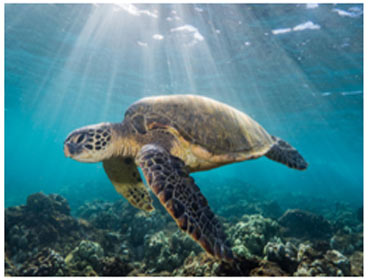Scientific classification
| Kingdom | Animalia |
| Phylum | Chordata |
| Class | Reptilia |
| Clade | Perichelydia |
| Order | Testudines |
Turtles are reptiles of the order Testudines marked by a special bony or cartilaginous shell established from their ribs and functioning as a shield. Turtles are both water and terrestrial. In aquatic forms, they might be freshwater or marine water living.
A turtle’s diet varies significantly depending upon the environment in which it lives. Adult turtles generally eat marine plants, invertebrates such as small insects, snails, and worms, and have been reported to sometimes eat dead marine animals. Sea turtles usually eat jellyfish, sponges, and other soft-bodied organisms.
In February 2011, the Tortoise and Freshwater Turtle Specialist Group released a report about the top 25 species of turtles probably to become extinct, with an additional 40 species at a very high risk of ending up being extinct. Asian species are the most endangered. So, the preservation of turtles is essential to maintain them and to stop their extinction otherwise which will adversely impact the ecosystem.
Here are a few famous types of turtles
Leatherback sea turtle
Scientific name: Dermochelys coriacea
The leatherback sea turtle is the largest of all living turtles and is the fourth-heaviest modern-day reptile. These reptiles have the largest distribution. The three major, areas of populations happen in the Atlantic, eastern Pacific, and western Pacific Oceans.
While the little study has actually been done on Leatherback sea turtle populations in the Indian Ocean, nesting populations are from Sri Lanka. Leatherback turtles generally eat jellyfish. Leatherbacks also feed on other soft-bodied organisms, such as tunicates and cephalopods.

Loggerhead sea turtle
Scientific name: Caretta caretta
The loggerhead sea turtle is the world’s biggest hard-shelled turtle. Loggerhead sea turtles spend most of their lives in the open ocean and in shallow seaside waters. They are native to Florida, Virginia, Brazil, and Canada. Some are likewise belonging to the Arabian sea.
The loggerhead reaches sexual maturity within 17– 33 years and has a life-span of 47– 67 years. The loggerhead sea turtle is omnivorous, mainly feed on bottom-dwelling invertebrates in oceans.

Green sea turtle
Scientific name: Chelonia mydas
Its range extends throughout tropical and subtropical seas around the world, with two distinct populations in the Atlantic and Pacific Oceans, however, it is also present in the Indian Ocean. The common name describes the typically green fat present below its carapace, not to the color of its carapace, which is olive to black.
The grownups normally inhabit shallow waters, feeding primarily on various species of seagrasses. Green sea turtles play an important function within the ecosystem in which they live. In the seagrass beds, the turtles eat the seagrass by cutting just the toppings and leaving the roots of the plant. Through their feeding strategy, the turtles assist to enhance the health and development of the seagrass beds.

Hawksbill sea turtle
Scientific name: Eretmochelys imbricata
The hawksbill’s look is similar to that of other marine turtles. In general, it has actually a flattened body shape, a protective carapace, and flipper-like limbs, modified for swimming in the open ocean.

Adult hawksbill sea turtles are mainly found in tropical coral reefs. While they are omnivorous, sea sponges are their principal food; they make up 70– 95% of the turtles’ diets. They also feed on the dangerous jellyfish-like hydrozoan.
Olive ridley sea turtle
Scientific name: Lepidochelys olivacea
The species is the second smallest and most diverse of all sea turtles found in the world. They are present in warm and tropical waters, primarily in the Pacific and Indian Oceans, but also in the warm waters of the Atlantic Ocean. Olive ridley is occasionally found in open waters.

The olive ridley is predominantly meat-eating, specifically in immature stages of the life process. Animal prey consists of protochordate or invertebrates, which can be caught in shallow marine waters environments. Typical food of olive turtles consists of jellyfish, tunicates, sea urchins, bryozoans, bivalves, snails, shrimp, crabs, rock lobsters, and sipunculid worms.
Fun Facts
- The leatherback sea turtle is the largest of all living turtles and is the fourth-heaviest modern-day reptile.
- The loggerhead sea turtle is the world’s biggest hard-shelled turtle.
- The loggerhead sea turtle has a life-span of 47– 67 years.
- Green sea turtles are named due to the green fat present below their carapace, not to the color of their carapace.
- Sea sponges are their principal food of hawksbill sea turtles; they make up 70– 95% of the turtles’ diets.
- The olive ridley sea turtle is the second smallest and most diverse species of all sea turtles.

